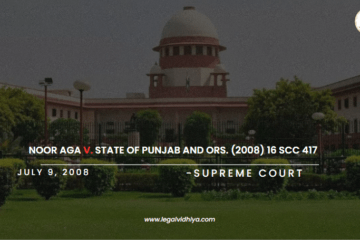
| CITATION | 2015 SCC ONLINE NCDRC 1404 |
DATE OF JUDGMENT | MAY 5, 2014 |
COURT | NATIONAL CONSUMER DISPUTES REDRESSAL |
APPELLANT | BIBEKANANDA PANIGRAHI |
RESPONDENT | PRIME HOSPITALS LTD. & ORS. |
BENCH | HON’BLE MR. JUSTICE J.M. MALIK, PRESIDING MEMBER HON’BLE DR. S.M. KANTIKAR |
FACTS
The Commission was considering an appeal submitted by a person whose father had appendicitis. Following the Respondent Doctor’s procedure, the patient experienced faecal fistula, septicemia, and eventually passed away. The appellant addressed the State Consumer Commission, claiming that his father had appendicitis and that it could be cured with medication. Additionally, the patient died as a result of the Respondent Doctor’s improper execution of the procedure, which led to the development of a faecal fistula.
ISSUE
Did the Opposing Parties (Doctors) provide insufficient services?
CONTENTION FROM COMPLAINANT SIDE
The patient had appendicitis, which could be addressed with medication, fiercely contended learned counsel for the complaint. The OP-2 failed to execute the operation correctly. Consequently, faecal fistula formed in the patient, who later had septicemia and died. OPs acted completely irresponsibly.
CONTENTION FROM OPPOSITION SIDE
The case put out by OP-2 was that the patient was a personal friend and classmate, and that every effort was made to treat him. After a cautious operation, the patient’s severe gangrenous appendicitis was treated. The gaping hole resulted from a delayed healing process rather than any neglect on the side of OP. There was no break in the post-operative care or the course of therapy. 45 days were spent treating the patient. After being discharged on his own, the patient enrolled at SCB Medical College. Thus, the hospital and the physicians did not act negligently.
ANALYSIS
The patient had a high-grade fever and a lump in the right iliac fossa (RIF), leading to an appendectomy. The abdominal wall was opened by a right para median incision, revealing pus in the peritoneal cavity and gangrenous appendix in para coecal position. The patient was treated with higher antibiotics, but after removing stitches, there was a gaping wound with pus discharge and a fecal fistula. The patient was managed by the OP, who also consulted an endocrinologist to control diabetes with insulin doses. The patient had high blood urea and creatinine, so he consulted a nephrologist for treatment. Blood transfusion IV, parenteral intravenous proteins, and vitamins were given to improve anemia and hyperproteinemia. The wound was dressed 3-4 times per day to keep it clean and dry. The patient presented with acute appendicitis for four days, with a temperature of 102°F and an ultra-sonographically confirmed mass in the RIF. The patient’s blood sugar was 210 mg% at admission, and kidney functions were disturbed. The patient had hypertension and was on medication for the last 10 years.
JUDGEMENT
- Doctrine of Res-ipsa loquitor (meaning, things speak for themselves):The formation of the faecal fistula in this case was a sequel to gangrenous appendicitis, and the patient’s diabetes was an additional factor contributing to the wound’s poor healing, therefore the court decided not to apply this theory.
- Reliance on Medical Literature: One of the most often performed surgical procedures is appendectomy. Although it is an uncommon complication, post-appendectomy faecal fistula formation can result in serious complications. In the absence of distal obstruction and underlying pathology, the majority of faecal fistulae respond to conservative treatment.
Feeling wronged by the State Commission’s dismissal of the case, the appellant filed an appeal with the NCDRC. Following review of the patient’s medical records and interview with both parties, the NCDRC noted that the patient had a high temperature and acute appendicitis. Upon arrival, the patient’s blood sugar level was also quite elevated. The patient’s diabetes was another factor contributing to the wound’s slow healing. The Commission also reviewed a number of surgical textbooks and medical journals, noting that up to 30% of cases of septic complications—such as wound infection, intra-abdominal abscess formation, fistula formation, and localised or diffused peritonitis—occur when the appendix is perforated or gangrenous with peri-appendicitis. With the greatest care, the OP (Doctor) performed an emergency operation on him. The medical state of the patient led to the development of a faecal fistula. Blood urea and creatinine levels were elevated, and the patient had severe diabetes. Additionally, the patient had regular dressing changes and medicines from the OP (Doctor), who took good care of the fistula. There were several reasons behind the death. So, neither the appendicectomy procedure nor the faecal fistula therapy included any carelessness. The appeal was thus rejected.
REFERENCE:
https://clap.nls.ac.in/wp-content/uploads/2015/01/clapnewsletterfeb2016.pdf
SCC ONLINE
This Article is written by Ananya Purwar student of Symbiosis Law School, Nagpur; Intern at Legal Vidhiya.
Disclaimer: The materials provided herein are intended solely for informational purposes. Accessing or using the site or the materials does not establish an attorney-client relationship. The information presented on this site is not to be construed as legal or professional advice, and it should not be relied upon for such purposes or used as a substitute for advice from a licensed attorney in your state. Additionally, the viewpoint presented by the author is of a personal nature.




0 Comments